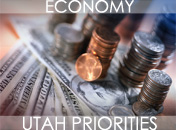
This recession was also arguably the worst recession since 1945, with job growth at the lowest rates since that time, and high unemployment and low labor force participation rates rivaling those seen in the recession that occurred in the early 1980s.
Utah’s job growth was stronger than the nation’s before and after the recession, but dipped below the national average during the recession. Utah’s rate of job growth remained below the nation’s until the spring of 2010, and is currently well above it.
Several populations were particularly affected by job losses, as shown in declining employment-to-population ratios. In Utah, those aged16-19 saw a reduction in the employment-to-population ratio of 14.1% from 2007 to 2010. The decline for the entire population 16 years and over was 4.8%. American Indian and Hispanic populations were also affected more than Utah’s white population. Utahns with lower educational attainment also saw this ratio decline much more than for college graduates.
Labor force participation declined much more significantly in the most recent recession than in previous ones. Utah experienced the largest decline in labor force of all 50 states, declining from 72.2% of the civilian population in 2007 to 67.1% in 2011, a decrease of 5.1 percentage points. Despite this, Utah still has a relatively high proportion of its population in the labor force, ranking 16th highest in the nation in 2011.

